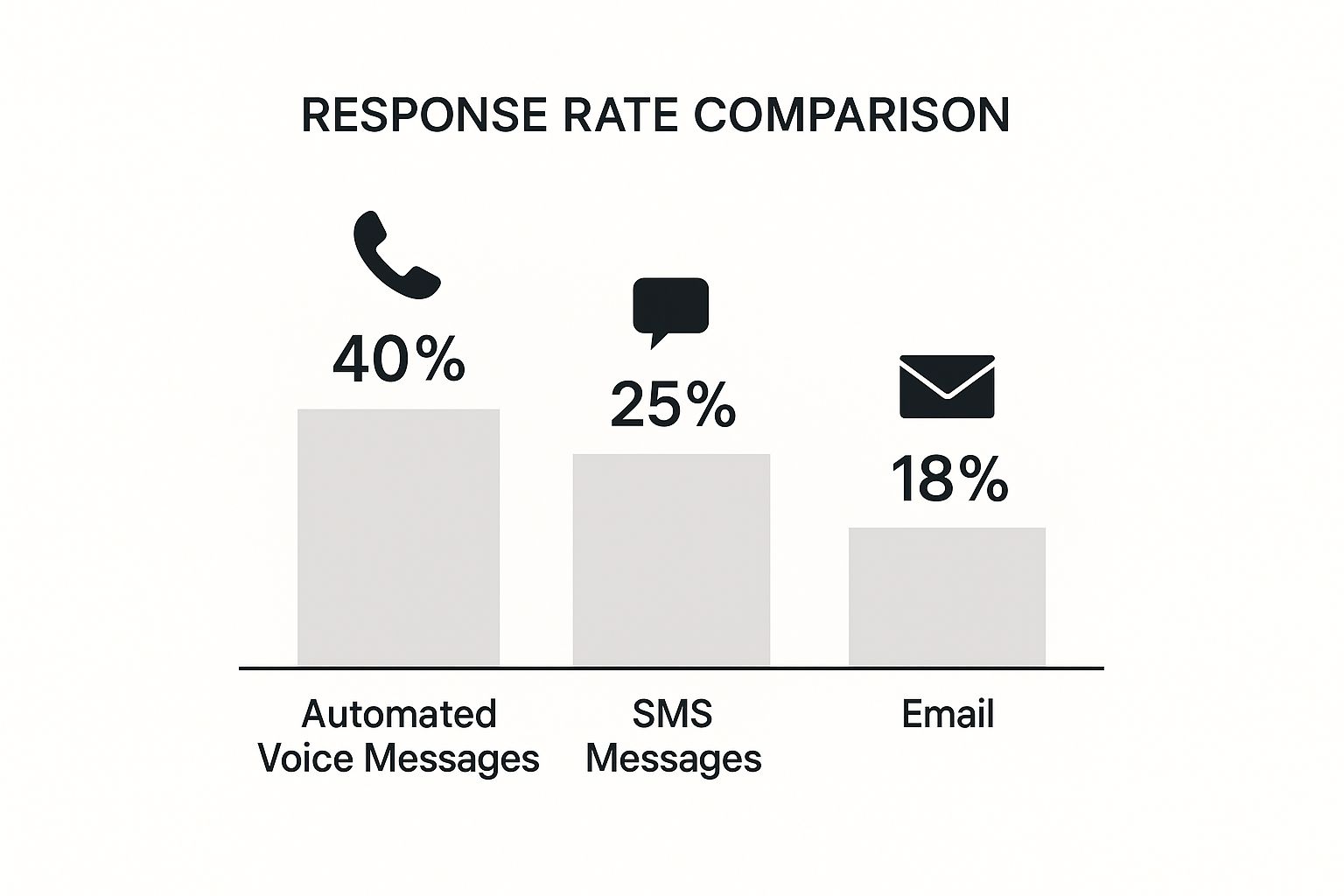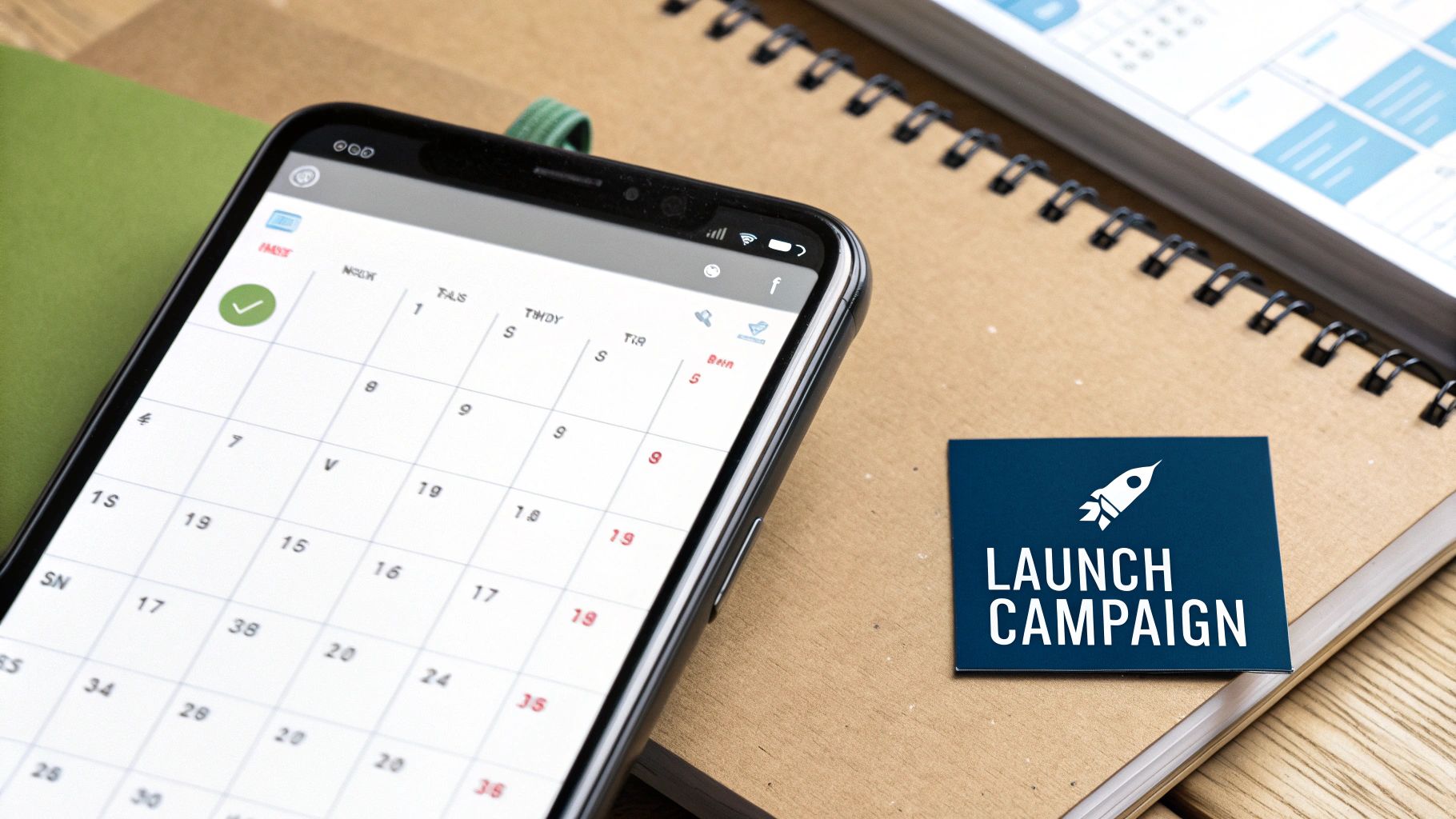An automated voice message is a simple concept: it's a pre-recorded audio clip you can send to a whole list of contacts without having to dial a single number. But don't mistake this for those generic, annoying robocalls. Done right, this technology lets small businesses create personal, scalable connections that actually feel human and can seriously boost response rates.
Let's be real. Your customers' inboxes are a warzone. Between emails, text messages, and social media DMs, cutting through the digital noise is a daily battle. An automated voice message gives you a secret weapon by engaging a completely different sense: hearing.
The human voice carries tone, emotion, and sincerity that a block of text just can't match. It’s this personal connection that makes your message stick.
Think about the real-world impact. A local contractor could send a warm, friendly follow-up after dropping off a quote, making that potential client feel seen and valued. Or an e-commerce store could leave a genuine thank-you message after a customer's first purchase, building instant rapport that encourages them to come back. These small, automated touches are what build a standout customer experience.
The biggest win here is differentiation. While your competitors' emails are getting buried, flagged as spam, or just plain ignored, a voice message lands right where a customer's most important calls do: their voicemail.
This isn't about interrupting someone's day with an unwanted call. It’s about leaving a non-intrusive message they can listen to whenever it's convenient for them. This respectful approach is a big reason why engagement is often so much higher than with other channels.
The numbers don't lie. When you look at how people respond to different types of outreach, voice messages often come out way ahead.

As you can see, voice messages can pull in a response rate nearly double that of email. That makes it an incredibly powerful tool for turning leads into customers.
This isn't just about blasting out the same generic recording to everyone. Modern systems allow for dynamic personalization, which is a fancy way of saying you can automatically insert a lead’s name, their appointment time, or the specific service they were interested in right into the audio. Suddenly, a mass broadcast feels like a one-on-one conversation.
An automated voice message blends the scalability of digital marketing with the personal touch of a traditional phone call. It’s a strategy that builds trust and prompts action precisely because it feels more human.
By bringing this strategy into your business, you can:
Ultimately, using automated voice messages sets the stage for higher conversions. You're creating memorable, positive interactions that most of your competitors are completely overlooking.

Alright, let's talk about the single most important decision you'll make in this entire process: picking the right platform. This is the foundation of your whole voice message strategy. It’s easy to get distracted by flashy websites and long feature lists, but what really matters is finding a tool that will actually help you convert leads.
The market for these services is blowing up for a reason. Businesses are realizing just how effective direct voice communication can be. In fact, the global voicemail service market is on track to hit $2.5 billion by 2025, growing at a steady clip of about 12% every year. More options are great, but it also means there’s more noise to cut through.
When you start comparing platforms, ignore the fluff. Focus on the core functions that have a direct line to your bottom line. These are the absolute must-haves.
First up, seamless CRM integration. This isn't just a nice-to-have; it's critical. The real power of an automated voice message comes alive when it's triggered by a specific action a lead takes, like filling out a form on your website. Your chosen platform needs to pull lead data from your CRM and—just as importantly—push call results right back into it without you lifting a finger.
Next, you need dynamic personalization. A generic, one-size-fits-all message is a one-way ticket to the delete button. Your platform has to let you insert a lead's name, the specific service they asked about, or even an appointment time right into the audio. Think about it: a message that says, "Hi Alex, this is a follow-up about your inquiry for plumbing services," is worlds more effective than a blast to "our valued customer."
Finally, demand robust analytics. If a platform can only tell you how many calls it made, walk away. You need real, actionable data.
The goal isn't just to send messages; it's to start conversations. A platform without detailed analytics is like flying blind—you'll be burning through your budget with no idea what's actually working.
Once you've nailed down the essential features, it's time to find a model that fits your business size and budget. There are tons of great best tools for automated marketing out there, and they generally fall into a few different buckets.
You’ll typically run into two main pricing structures:
A couple of other things to keep an eye on. How good are the AI voices? A robotic, clunky voice will sabotage your efforts before you even get started. The best platforms offer a library of surprisingly human-sounding voices. Also, make sure the platform has built-in tools to help you with TCPA compliance, like simple opt-out management. The last thing you want is a legal headache.
Choosing a platform isn't just about price; it's about finding the right fit for your team's technical skills and your long-term goals. Here’s a quick breakdown of the common types of platforms you’ll encounter.
Ultimately, the best platform is the one that grows with you. An all-in-one suite might be perfect today, but make sure it has the power and flexibility you’ll need a year from now as your business scales.

A powerful automated voice message lives and dies by its script. It’s not just about what you’re saying, but how you say it. The goal is to come across as a helpful human, not an annoying robot. So, ditch the corporate jargon and stiff language. You need to write for the ear, using a casual, conversational tone that builds an instant connection.
Your script is your one and only shot to grab someone’s attention and get them to take action. A bad message is worse than no message at all—it can tarnish your brand and get your number blocked for good.
You have an incredibly short window to hook your listener. If the first few seconds don’t immediately tell them who you are, why you’re calling, and what’s in it for them, they’re gone. They’ll either hang up or delete the message without a second thought.
You have to start strong and get straight to the point. Clearly state your name, your company, and the reason for the call.
See the difference? The second example is direct, personal, and immediately relevant. It gives the listener context and a compelling reason to keep listening.
The sweet spot for an automated voice message is under 30 seconds. Go any longer, and you'll lose them. People are busy, and their voicemail inbox is just another task on their overflowing to-do list.
I’ve found that a tight, three-part structure works best:
This structure forces you to be clear and punchy. You respect their time while still getting your main point across. And mastering this is more important than ever. The voice assistant market was valued at USD 7.35 billion in 2024 and is expected to explode to USD 33.74 billion by 2030. You can discover more about the voice assistant market growth on nextmsc.com. This massive growth shows just how critical getting voice communication right has become.
The single biggest mistake in scripting is trying to say too much. An effective voice message isn't a sales pitch; it's a conversation starter designed to prompt a single, simple action.
Your call-to-action (CTA) needs to be crystal clear and dead simple to follow. Don't confuse the listener by asking them to do multiple things. Give them one specific, low-effort next step.
The strong CTA is specific and effortless. It guides the lead toward a simple action they can take right now, on their phone. A good pro-tip is to repeat a phone number or website URL, since they probably don't have a pen ready the first time they hear it. Making your CTA easy to remember and act on is what will ultimately drive your conversions.

Alright, you’ve got a killer script ready to go. Now for the fun part: bringing your campaign to life. This is where we shift from planning to doing, setting up the tech that gets your message into the right ears at the perfect moment. It might sound complicated, but it’s really just a few key steps.
The absolute first thing you need to handle is your contact list. I can't stress this enough: only upload contacts who have explicitly given you permission to reach out. A clean, opt-in list isn't just about good manners; it's your number one defense against compliance headaches and ensures your message lands as a helpful follow-up, not spam.
Getting your contacts into the system is easy. The real leverage comes from segmentation. Blasting the same generic message to your entire list is a rookie mistake and a massive missed opportunity. To get real results, you need to group contacts by what they have in common.
Think about how you can slice up your list:
Proper segmentation makes your automated message feel surprisingly personal. It shows you're actually listening, which is huge for building trust and boosting response rates.
Timing is everything. A call at 2 AM is a guaranteed way to lose a customer forever. A call mid-morning on a Tuesday, however, could be the perfect time to connect.
The ideal send time really boils down to who you're calling.
Pro-Tip: My rule of thumb for B2B campaigns is to aim for mid-week, during standard business hours (10-11 AM or 2-4 PM). For B2C, you can often get great results in the late afternoon or early evening. But always, always respect local time zones.
Nearly every voice platform worth its salt will let you schedule broadcasts in the recipient's local time. It's a non-negotiable feature you should be using every single time. Start with these best practices, then dive into your campaign analytics to see what’s working and tweak from there.
To keep your messages from sounding like a robot, use personalization tokens. These are simple placeholders like [FirstName] or [ServiceName] that the system automatically swaps with the right information from your contact list. It's a small detail that makes a world of difference.
This is where modern Text-to-Speech (TTS) technology really shines. TTS solutions currently hold a massive 61.8% of the voice technology market share, which tells you just how much businesses rely on creating these kinds of natural, dynamic interactions. You can read the full analysis of the voice assistant market on nextmsc.com for a deeper dive.
Platforms like Twilio are often the engine behind these tools, providing the APIs that power everything from voice to messaging.
Finally, let's talk compliance. This isn't optional. Under the TCPA regulations in the U.S., you absolutely must:
Running an ethical, legal campaign is the only way to do business. It protects your company and builds the kind of trust that turns leads into loyal customers.
Getting your automated voice message campaign live is a great first step, but it's really just the beginning. The real magic happens when you start digging into the data, turning those raw numbers into insights that actually improve your results.
If you aren't measuring, you're just guessing. When you track performance, you're building a repeatable system for converting leads.
Forget about vanity metrics like how many messages you've sent. That number doesn't tell you much. Instead, you need to zero in on the key performance indicators (KPIs) that directly show engagement and intent. These are the numbers that reveal if your strategy is actually connecting with people.
Your analytics dashboard is your new best friend. Seriously, you should be checking these numbers obsessively:
A huge part of optimizing your campaign is understanding how to measure marketing ROI from your voice message efforts. Connecting these metrics back to actual sales is what proves the value of what you're doing.
The growth in this space has been mind-blowing. By 2024, there were an estimated 8.4 billion voice assistants in use around the world, which shows just how comfortable people have become with voice interactions. You can discover more insights about Voice AI growth on verloop.io.
Data tells you what's happening, but A/B testing helps you figure out why. The process is simple: you create two versions of a single element in your campaign (we'll call them A and B), send them to different segments of your audience, and see which one performs better. It’s a straightforward but incredibly powerful way to make small improvements that can lead to massive gains over time.
The goal of A/B testing isn't to find one perfect message. It's to create a continuous feedback loop where every campaign teaches you something new about what your audience responds to.
To get started, focus on tests that can have the biggest impact. Don't waste time A/B testing tiny word changes at first. Instead, test the big-picture variables:
By isolating just one variable at a time, you can clearly see what's causing the difference in performance. This is how you systematically build a more effective automated voice message strategy, one test at a time.
Whenever you're exploring a new way to reach customers, a few key questions always pop up. It's only natural. With automated voice messages, most business owners I talk to are concerned about the same things: legality, customer perception, and whether it actually works. Let's tackle these head-on.
Getting clear on the rules of the road and understanding how your audience will react is non-negotiable. If you get this right from the start, you'll build a strategy that's not just effective, but also ethical and builds trust.
Yes, they are—but you have to play by the rules, and this part is critical. The main piece of legislation you need to be aware of in the United States is the Telephone Consumer Protection Act (TCPA).
The TCPA is very clear: you must have prior express written consent before sending any automated or pre-recorded marketing messages to a person's mobile phone. This isn't just a box they check; the consent has to be completely unambiguous, making it crystal clear that they're agreeing to receive these types of messages from you.
Now, transactional messages—things like appointment reminders or shipping updates—are a different story and have slightly different guidelines.
The most important thing to remember is this: never, ever send an automated marketing message to someone who hasn't explicitly said "yes." You also need to give them a simple, obvious way to opt-out in every single message. When in doubt, talking to a legal professional is always your best bet to ensure you're 100% compliant.
This is the million-dollar question, and the answer comes down to two simple things: value and consent.
Let's be honest. An unsolicited, generic voice message blasted out to a list you bought somewhere? That's absolutely going to feel like spam, because it is spam. It's also the fastest way to get your number blocked and do some serious damage to your brand's reputation.
But what if you flip the script? Imagine a potential customer fills out a form on your website asking for a quote. Moments later, their phone rings with a message saying, "Hi Alex, this is Sarah from My AI Front Desk with that quote you just requested." That doesn't feel like spam at all. It feels like incredibly responsive, helpful customer service.
To make sure your messages land in the "helpful" category and not the "spam" bucket, just stick to these three principles:
When you get these elements right, an automated voice message becomes a welcome and powerful touchpoint, not a nuisance.
Ready to transform your lead follow-up with intelligent, automated voice messages? My AI Front Desk provides a powerful outbound dialer and AI receptionist to help you convert more leads and grow your revenue. Learn more about how My AI Front Desk works.
Start your free trial for My AI Front Desk today, it takes minutes to setup!








